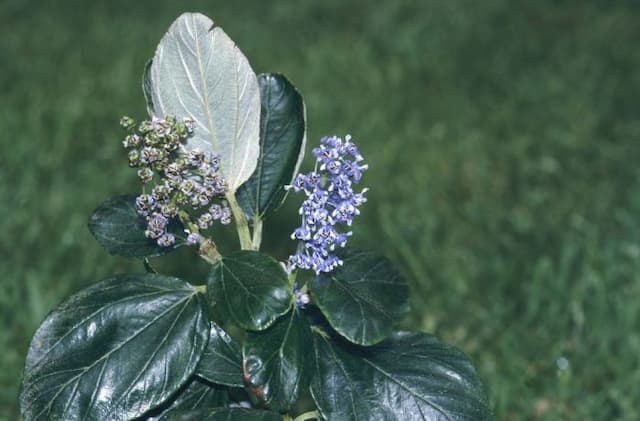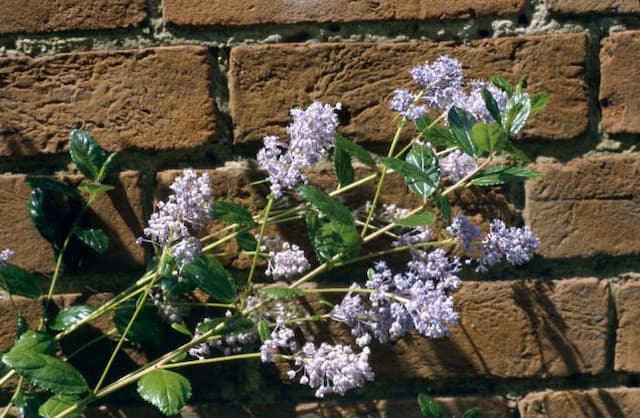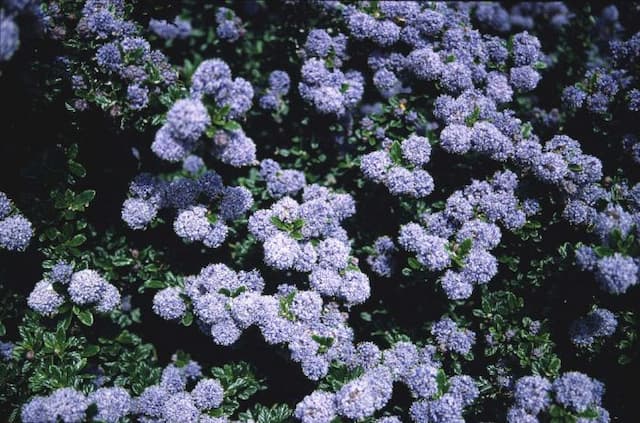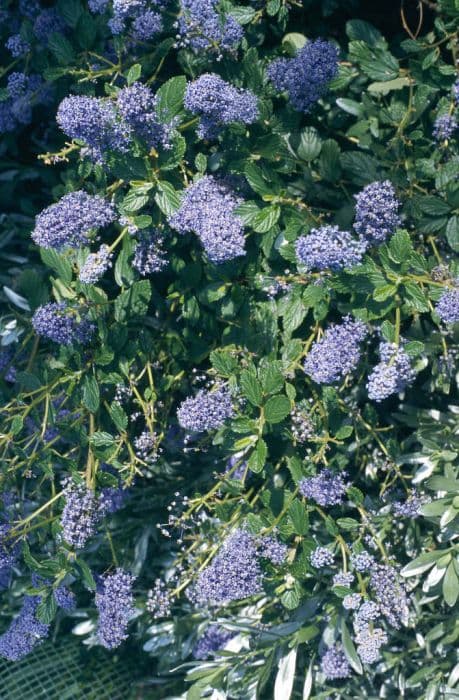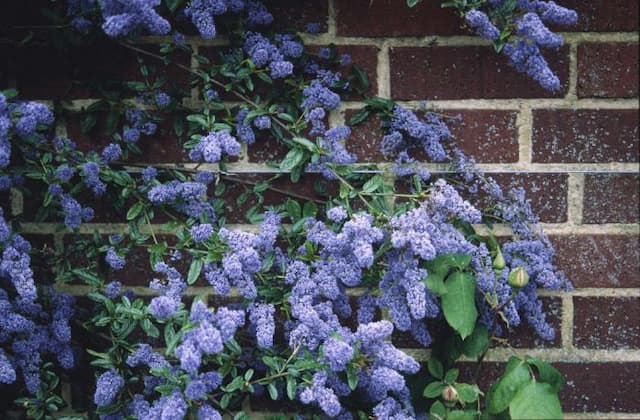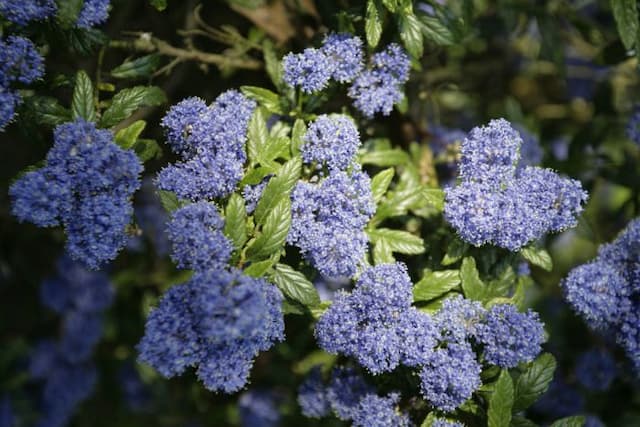Californian lilac 'Skylark' Ceanothus 'Skylark'

ABOUT
'Skylark' is a compact evergreen shrub with finely toothed, glossy dark green leaves and clusters of deep blue flowers in early summer
About this plant
 Names
NamesFamily
Rhamnaceae
Synonyms
California Lilac, Blueblossom
Common names
Ceanothus 'Skylark'.
 Characteristics
CharacteristicsLife cycle
Perennials
Foliage type
Evergreen
Color of leaves
Green
Flower color
Blue
Height
6 feet (1.83 meters)
Spread
6 feet (1.83 meters)
Plant type
Shrub
Hardiness zones
7
Native area
North America
Benefits
 General Benefits
General Benefits- Attractive Flowers: Ceanothus 'Skylark' produces a profusion of beautiful blue flowers that can add color and visual interest to a garden.
- Drought Tolerance: Once established, Skylark is known for its ability to withstand periods of drought, making it suitable for xeriscaping and water-wise gardens.
- Wildlife Habitat: It provides a source of nectar for bees, butterflies, and other beneficial insects, enhancing biodiversity.
- Low Maintenance: This plant requires minimal care once established, making it an ideal choice for gardeners seeking a low-maintenance landscape.
- Fast Growth: It has a relatively fast growth rate, allowing for quick establishment and filling in of garden spaces.
- Erosion Control: Ceanothus 'Skylark' can help in stabilizing slopes and preventing soil erosion due to its root system.
- Evergreen Foliage: It has evergreen leaves that provide year-round interest and structure in the garden.
- Versatility: The plant is versatile and can be used in a variety of garden settings, including borders, foundations, or as an informal hedge.
- Deer Resistance: Known to be resistant to deer, helps to prevent browsing damage in gardens where deer are a common problem.
- Fragrant Blossoms: The flowers emit a light fragrance, which can be very pleasing when planted in an area where it can be enjoyed up close.
 Medical Properties
Medical PropertiesThis plant is not used for medical purposes.
 Air-purifying Qualities
Air-purifying QualitiesThis plant is not specifically known for air purifying qualities.
 Other Uses
Other Uses- Ceanothus 'Skylark', commonly known as California lilac, can be used for erosion control on hillsides and slopes due to its dense root system that helps stabilize soil.
- California lilac can be used as a natural privacy screen or windbreak in gardens because of its bushy habit and fast growth rate.
- The plant serves as a host for butterfly larvae, specifically for the California Tortoiseshell, enhancing biodiversity and supporting butterfly populations.
- California lilac can be used in xeriscaping, a landscaping method that reduces or eliminates the need for supplemental water from irrigation.
- With its vibrant blue flowers, California lilac can be incorporated into cut flower arrangements to add a pop of color.
- It can be used as a natural dye; the flowers have been known to produce a greenish hue when used for dyeing fabrics.
- California lilac's dense foliage can be used as a sound barrier in urban gardens to reduce noise pollution.
- The dried flowers and leaves of California lilac can be used to make potpourri to freshen the air with a natural fragrance.
- It can be used as an alternative to grass in lawns, providing a low-maintenance, drought-resistant ground cover.
- When planted along the coast, California lilac can act as a buffer to salt spray, protecting more delicate plants in seaside gardens.
Interesting Facts
 Feng Shui
Feng ShuiThe California lilac is not used in Feng Shui practice.
 Zodiac Sign Compitability
Zodiac Sign CompitabilityThe California lilac is not used in astrology practice.
 Plant Symbolism
Plant Symbolism- Endurance: Ceanothus, commonly known as California Lilac, often symbolizes endurance due to its ability to survive in dry climates and poor soil, representing the capacity to endure and thrive in challenging conditions.
- Hope: The lush blooming of the California Lilac in various shades of blue can signify hope, much like the clear blue of the sky that it may resemble.
- Patience: This plant typically grows slowly and requires patience for it to reach full maturity, hence it can be associated with the virtue of patience and the rewards that come with it.
- Renewal: As an evergreen plant, the California Lilac represents renewal and the constant renewal of life, reflecting an evergreen spirit or a fresh start.
- Pioneering: Since Ceanothus species are often among the first plants to re-colonize areas cleared by fire, it symbolizes pioneering and the ability to initiate new beginnings after a period of destruction or hardship.
 Water
WaterCalifornia lilac 'Skylark' should be watered thoroughly, allowing soil to dry out between waterings. Initially, water young plants deeply once a week, and once established, they require less frequent watering. During the growing season, provide about 1-2 gallons per plant every two weeks, adjusting for rainfall. Drought-tolerant once established, 'Skylark' tolerates dry conditions, but in prolonged dry spells, an occasional deep watering is beneficial.
 Light
LightCalifornia lilac 'Skylark' prospers best in full sun, thriving with at least 6 hours of direct sunlight each day. An ideal spot would be a south-facing garden where it has maximum exposure to sunlight. It can tolerate partial shade, but too much shade may limit flowering and can cause leggy growth.
 Temperature
TemperatureCalifornia lilac 'Skylark' is hardy in temperatures ranging from as low as 10 to 15 degrees Fahrenheit to as high as 85 to 95 degrees Fahrenheit. It prefers a moderate climate and can tolerate occasional dips in temperature, but prolonged exposure to extremes outside this range may harm the plant. The ideal temperature for this shrub is between 60 to 75 degrees Fahrenheit.
 Pruning
PruningPrune the California lilac 'Skylark' to maintain shape and encourage bushier growth, and to remove any damaged or dead branches. Light pruning is best done immediately after blooming, typically in late spring or early summer, so as not to remove next year’s blooms. 'Skylark' doesn’t require heavy pruning, and over-pruning can be detrimental to its natural shape and flowering.
 Cleaning
CleaningAs needed
 Soil
SoilCalifornia lilac 'Skylark' thrives in well-draining soil with low to moderate fertility; it prefers a soil pH of 5.5 to 7.5. The best soil mix can be made from a combination of garden soil, peat moss, and coarse sand to ensure adequate drainage. It’s important to avoid waterlogged conditions as this can lead to root rot in the plant.
 Repotting
RepottingThe California lilac 'Skylark', being a shrub, is typically not repotted often once it is planted in the ground. However, if grown in containers, it should only be repotted when it has outgrown its current pot, which is generally every 2 to 3 years to avoid disturbing its roots excessively.
 Humidity & Misting
Humidity & MistingCalifornia lilac 'Skylark' is tolerant of various humidity conditions and does well in the moderate humidity found in most outdoor environments. It is a relatively drought-tolerant plant and does not require high humidity levels, making it suitable for typical garden settings.
 Suitable locations
Suitable locationsIndoor
Provide bright light, avoid overwatering, ensure good air flow for California lilac 'Skylark'.
Outdoor
Plant in sunny spot, well-draining soil, water sparingly for California lilac 'Skylark'.
Hardiness zone
7-10 USDA
 Life cycle
Life cycleCeanothus 'Skylark', commonly known as the 'Skylark' California lilac, begins its life cycle when seeds germinate, typically in the spring following winter chill, which breaks seed dormancy. Seedlings rapidly establish a root system and begin producing their characteristic glossy green leaves. As the plant matures, usually within a few years, it develops woody stems and starts to form dense, rounded to upright shrubs. In late spring to early summer, 'Skylark' bursts into bloom with profuse clusters of deep blue flowers, attracting pollinators like bees and butterflies. After pollination, it produces dry, capsule-like fruits that disperse seeds for the next generation. Ceanothus 'Skylark' can live for several years, and with proper care, they can thrive for a decade or more before senescence takes place.
 Propogation
PropogationPropogation time
Spring to early summer
The Ceanothus 'Skylark', also known as California Lilac, is commonly propagated through semi-hardwood cuttings. The best time for taking semi-hardwood cuttings is in late summer. To propagate by cuttings, one should select a healthy, disease-free branch. A cutting of about 4-6 inches long should be made, with the lower leaves removed and the cut end dipped in rooting hormone. The cutting is then placed in a well-draining soil mix and kept moist. Setting the pot in a warm area with indirect sunlight encourages root development. Cuttings usually root after several weeks, after which they can be potted up individually.
